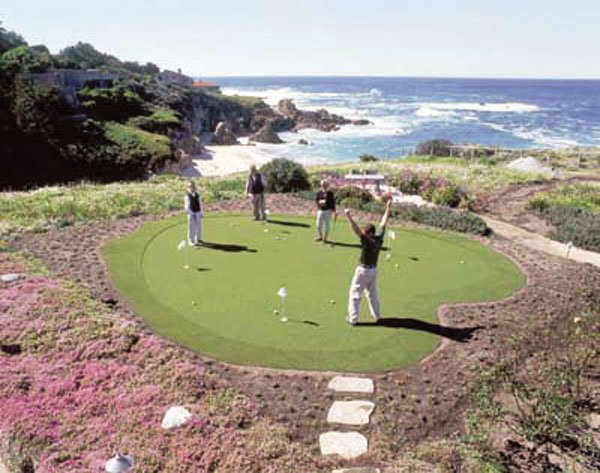William Ashby was relaxing at home on a recent Sunday, enjoying
his latest copy of Golf Digest when he ran across an interesting
new putting technique. Curious to try it out, the Monterey resident
wasted no time. He grabbed his putter and hit the backyard
green.
William Ashby was relaxing at home on a recent Sunday, enjoying his latest copy of Golf Digest when he ran across an interesting new putting technique. Curious to try it out, the Monterey resident wasted no time. He grabbed his putter and hit the backyard green.
That’s right. Ashby has a putting green in his own back yard in Monterey. And unlike a decade ago, when a serious golfer bent on having a serious green had to water, mow and treat his own turf daily, the 60-year-old doesn’t have to work for the privilege of putting around out back.
Synthetic putting greens have come a long way since the days of green carpet and Astro-turf. Today’s are nearly indistinguishable from grass. They’re made to look, feel and perform like the real deal, helping avid golfers improve their handicaps without damage the chemicals and large amounts of water a real-grass putting green requires. Potential owners just shouldn’t expect the same for their pocket books.
“For 1,000 square feet, you’re probably looking at $15,000 to $18,000 based on what a person wants and access to the facility,” said Jeff Martin, a salesman for the synthetic green installation service Perfect Putt in San Jose. Perfect Putt is a franchise of the nationwide company Southwest Greens. “It’s a luxury item, basically, but there’s no maintenance, an 8-year warranty and the amount of water you’re going to save over time should make it pretty well pay for itself.”
The extra expense of any putting green is worth the effect on one’s game, according to Greg Pickens, a landscape designer for Monterey-based Home Game L.P., another synthetic turf installer.
“Nobody likes to practice putting,” said Pickens. “People go to a driving range, but they spend maybe one-tenth of their time practicing on the things that really matter. Putting accounts for half the strokes during a golf round. With the putting green in your back yard, it’s so easy to go out and do it that you can do it with breakfast or when you go home – take a glass of wine and go chill on the green.”
For homeowners who are thinking of putting in their own putting greens, the choice between synthetic and real grass comes down to a question of time and desire, according to Leo Melanson, author of the “Beginner’s Guide to Backyard Golf Putting Greens.”
Melanson built his own backyard green for less than $1,000, shaping a base layer that he covered in crushed stone, sand and peat to allow for drainage and root growth. However, the costs to maintain his suburban paradise have not been cheap.
Greens require constant attention, wrote Melanson, from mowing and watering – a chore he does every two to three days – to monthly applications of fertilizer and fungicide, bimonthly top dressings and yearly core aeration, not to mention spot treatments with herbicides and pesticides as needed.
Synthetic greens, by comparison, can be shaped, placed and finished by professional installers in two to five days, said Pickens.
For most backyard putting and chipping – at least, anything under a distance of 30 feet – Pickens recommends installing synthetic turf with a sand base.
Basically, Pickens’ crew forms the green, then creates an undulating drainage area out of decomposed granite, stopping every two inches to machine-compact it before adding another layer.
The nylon “grass” is stretched over this, then weighed down with manmade sand that fans the blades of grass to an even spread, just like real turf.
“When you place the holes, you want to have some challenges to practice on, so you want an uphill shot, a downhill, and then right and left breaks,” said Pickens. “You’re going to have low spots, too, so you need to have a design that has an adequate drainage system.”
Martin also recommended a 12-foot straight put, which allows golfers to observe their own putting weaknesses more accurately and practice their stroke techniques.
For larger areas – say, a green designed to take a shot from 100 yards – Martin recommends his polypropylene surface.
Like the nylon, polypropylene is weather-resistant, fade-resistant and gives a supremely realistic roll to the ball, but instead of placing the ground covering directly over gravel, a rubberized pad is placed in between.
“We recommend, depending on if you have a lot of foot traffic, that you roll it with a regular sod roller every six months, but that’s it,” said Martin.
Each green is custom-built, but for a truly luxe putting area, there are also optional upgrades. Pickens’ company can design a “golf practice facility” for an individual client, designing the putting surface so the golfer can work on his or her individual shortcomings. Martin’s parent company, Southwest Greens, has an exclusive design partnership with golf course designer Jack Nicklaus’ design firm, offering clients the chance to work directly with Nicklaus designers on their home projects.
For more information on synthetic golf course installation, call Perfect Putt at (408) 252-5838 or Home Game L. P. at (831) 643-0789.













